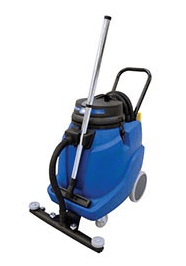Maintaining a clean and efficient grease trap might not be the most glamorous task in the food service industry, but it is undoubtedly crucial for the smooth operation of establishments, from school lunch programs to bustling restaurant chains.
Not only do state and local regulations require grease traps to be cleaned, but failure to do so can lead to some unpleasant consequences like foul odors, slow drains, clogs and even fines from inspectors.
Thankfully, its not as daunting as it seems.
In this comprehensive guide, we’ll walk you through the step-by-step process of cleaning out a grease trap efficiently, ensuring your kitchen stays in top-notch condition.
How to Clean a Grease Trap in 8 Steps
We’ve simplified the process of cleaning a grease trap into eight easy-to-follow steps.
To follow along with these steps, you’ll need the following equipment, materials, and supplies:
- Equipment
- Wet/Dry Vac
- Ladle
- Steel Pot Scrubber
- Crowbar or Wrench
- Materials
- Supplies
- Dish Soap
- Cool Water
- Warm Water
Once everything is in order, follow these eight steps:
- Step 1: Put on PPE
- Step 2: Run Cool Water Through the System
- Step 3: Remove the Grease Trap Lid
- Step 4: Remove the Layer of FOG
- Step 5: Use a Wet/Dry Vac to Remove Debris
- Step 6: Clean Tank Components
- Step 7: Flush Out Debris
- Step 8: Reinstall Baffles and Lid
Step 1: Put on PPE

Before starting any cleaning procedures, equip yourself with protective gloves, a nose plug, protective goggles, and protective coveralls. These precautions ensure protection against potential chemical hazards and harmful bacteria present in the grease trap.
Step 2: Run Cool Water Through the System
Begin by running cool water through the grease trap system. Allowing it to sit for about 10 minutes helps congeal fats, oils, and grease (FOG), making them easier to remove in subsequent steps.

Step 3: Remove the Grease Trap Lid
Carefully remove the grease trap’s lid. Some lids may require a crowbar or wrench, while others, especially plastic lids, can be easily popped off.
Step 4: Remove the Layer of Fats, Oils, & Grease
Using a ladle, scoop off the layer of congealed FOG floating on top of the water. Store the collected FOG in an air-tight container for proper disposal.
Step 5: Use a Wet/Dry Vac to Remove Debris

With the fats oils and greases removed, utilize a wet/dry vac to suction out any remaining water and solid debris from the grease trap. Make sure that all dishwashers and sinks are turned off to prevent continuous filling during the cleaning process.
Step 6: Clean Tank Components
Clean the tank walls, lid, and baffles using a solution of dish soap and warm water. Use a steel scrubber to eliminate any residue left in the tank. This helps eliminate any nasty odors left behind by the water and solid debris.
Step 7: Flush Out Debris
Pour a gallon of warm or room-temperature water down the drain to flush out any remaining soap or debris. Smooth water flow indicates a successful cleaning process.
If blockages persist, seek assistance from a licensed plumber.
Step 8: Reinstall Baffles and Lid
Once the grease trap is thoroughly cleaned, reinstall the baffles and cover the tank with the lid.
How Often Should A Grease Trap Be Cleaned?
A general rule of thumb, cleaning out a grease trap should take place when the grease or oil content reaches approximately 25% of the liquid level within the trap or when the tank is at around 15% capacity.
This guarantees that the trap functions optimally and doesn’t become a breeding ground for nasty odors and potential blockages. The specific timeline for cleaning can vary based on the grease volume generated by the facility, with the average being every 8 to 12 weeks.
Final Thoughts
Cleaning out a grease trap is undeniably a critical step in maintaining a smooth and efficient kitchen. From school lunch programs to bustling restaurant chains, the health and functionality of your establishment depends on the proper upkeep of the grease trap.
We’ve provided you with a comprehensive, step-by-step guide to make the process as straightforward as possible. By incorporating these practices into your routine, you not only eliminate foul odors and potential blockages but also contribute to the lifespan and efficiency of your grease trap.
Imperial Dade understands the challenges food service professionals face and is here to support you in maintaining the highest standards of cleanliness.
For a free evaluation of your food service operation or to discuss your specific needs, reach out to an Imperial Dade facility near you. Our food service specialists are ready to provide expert advice and assistance, ensuring your kitchen operations run seamlessly and hygienically.
Make the smart choice for your kitchen’s maintenance and contact an Imperial Dade facility near you.